Our tool for managing your permission to our use of cookies is temporarily offline. Therefore some functionality is missing.

INSPIRING DYNAMICS. IN EXACTLY THE RIGHT DOSES.
BMW EfficientDynamics in the BMW X3.
The BMW X3 is ready for any challenge. This is especially true of its drive system. With intelligent technologies from BMW EfficientDynamics as well as its advanced energy management, it offers driving pleasure and agility – and, at the same time, reduces fuel consumption and emissions.
The BMW X3 is ready for any challenge. This is especially true of its drive system. With intelligent technologies from BMW EfficientDynamics as well as its advanced energy management, it offers driving pleasure and agility – and, at the same time, reduces fuel consumption and emissions.
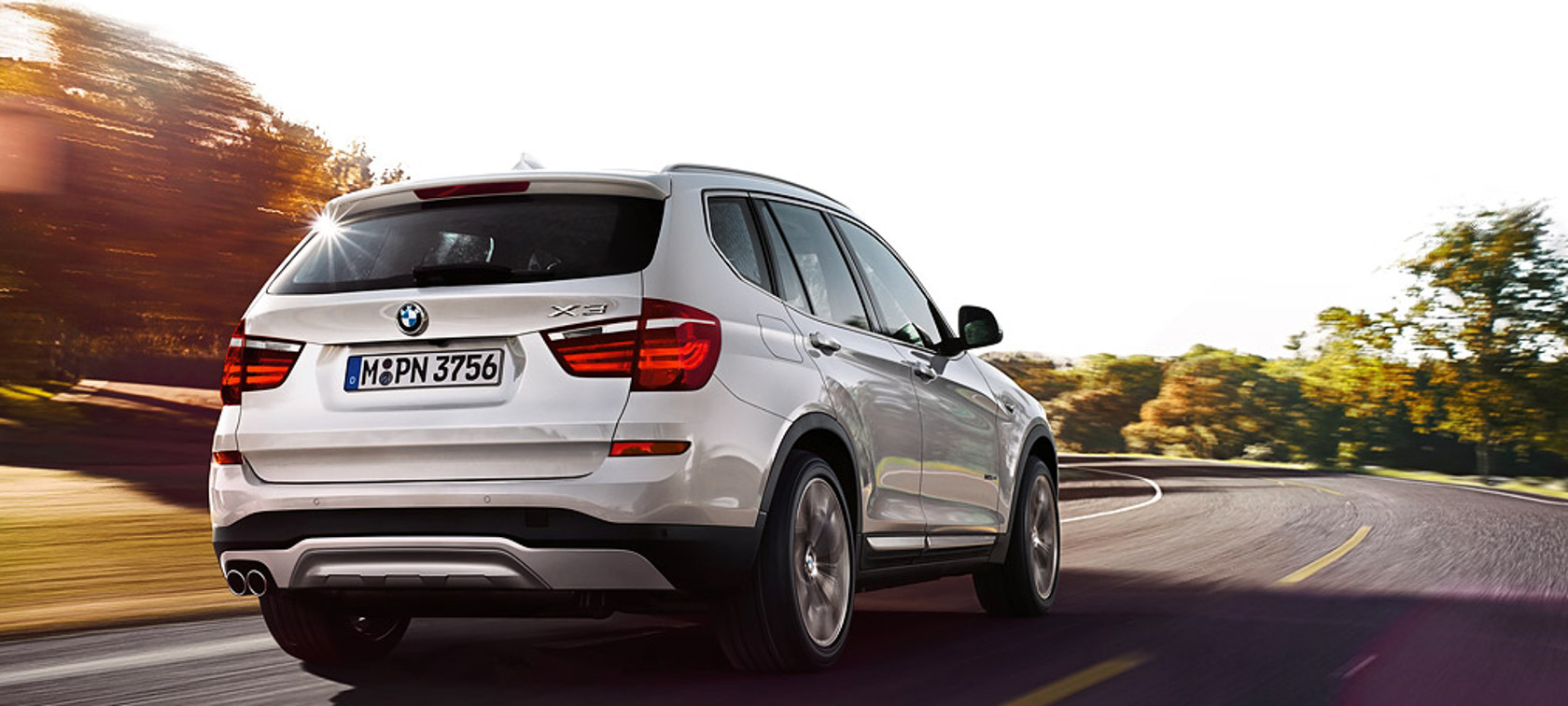
TECHNOLOGIES THAT UNITE DYNAMICS AND EFFICIENCY.
Economical BMW TwinPower Turbo engines, intelligent lightweight construction and refined aerodynamics are the ideal basis for efficiency, which is further increased by BMW EfficientDynamics technologies and options such as the eight-speed Steptronic transmission.
TECHNOLOGIES THAT UNITE DYNAMICS AND EFFICIENCY.
Economical BMW TwinPower Turbo engines, intelligent lightweight construction and refined aerodynamics are the ideal basis for efficiency, which is further increased by BMW EfficientDynamics technologies and options such as the eight-speed Steptronic transmission.

INTELLIGENT LIGHTWEIGHT CONSTRUCTION.
A wide range of high-tech materials are used in the construction of the BMW X3: lightweight aluminium, high-strength steel, state-of-the-art plastics and magnesium.
This intelligent lightweight construction reduces the weight of the vehicle, makes the car body exceptionally rigid, enhances passive safety and improves dynamics.
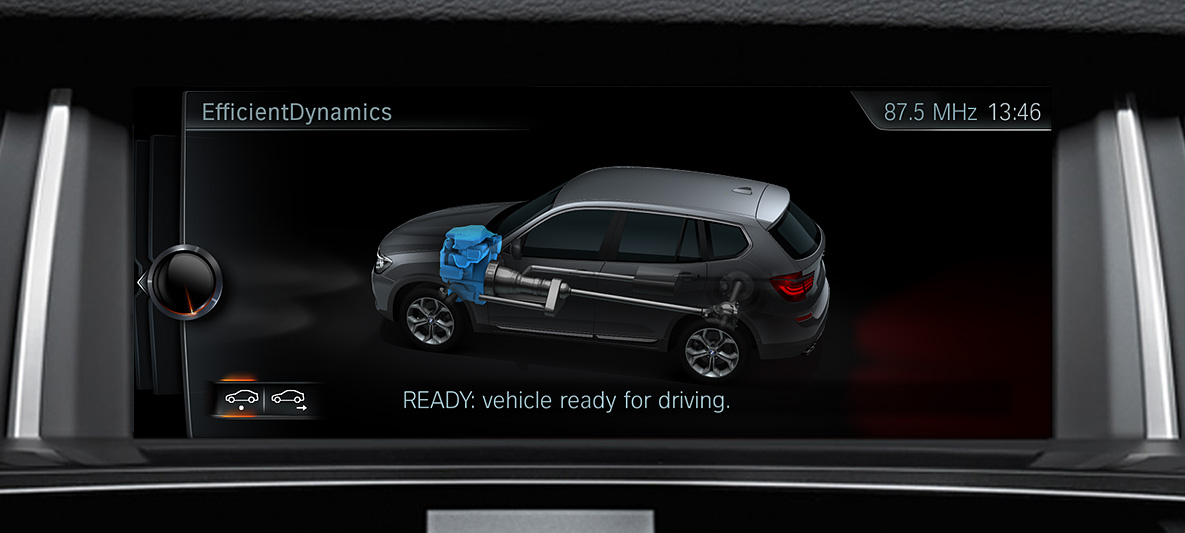

ENERGY MANAGEMENT.
The BMW X3 has standard-feature technologies on board that it uses intelligently for energy coordination. This energy management is the secret behind its high level of efficiency. Only when all these technologies interact is the vehicle able to achieve its impressive figures for fuel consumption and emissions.
-
Optimum Shift Indicator
Optimal, perfectly-timed gear changes can help save fuel, particularly in urban environments and over long distances. Optimal gear changes, less fuel consumption – the engine’s electronics system identifies the most efficient gear based on the driving situation and engine speed. An arrow lights up in the Info Display to show when it would be more efficient to shift into a higher or lower gear. The system also recognises when the car is accelerating quickly and will delay its recommendation accordingly until the engine speed has increased. Comparative tests have shown that vehicles with the Optimum Shift Indicator use around four percent less fuel.
-
Automatic Start/Stop function
The Automatic Start/Stop function makes sure that fuel is only used when the car is actually driving. When the vehicle comes to a temporary standstill, for example at traffic lights or in stop-and-go traffic, the Automatic Start/Stop function saves fuel by switching off the engine as soon as the car is idling and the foot is off the clutch (manual transmission ), or when the care brakes to a complete standstill (Steptronic transmission).
A signal in the Info Display indicates that the Automatic Stop/Start function is active. As soon as the clutch is pressed (manual transmission ) or the foot taken from the brake (Steptronic transmission), the engine turns itself back on automatically.
The Automatic Start/Stop function never compromises driving comfort and safety, as it remains inactive if the engine has not reached its ideal running temperature, the interior has not yet been sufficiently heated/cooled, if the battery level is too low or if the steering wheel is being turned. A central control unit restarts the engine if required, even when the car is at a standstill -- for example, if the car starts to roll forward or if the windscreen becomes foggy. The Automatic Start/Stop function can be switched off at any time with the push of a button.
-
Electric Power Steering
Every time the driver steers, energy is consumed. But why should energy be consumed when the wheel is not being turned? BMW Electric Power Steering is only active when it is needed. Unlike conventional hydraulic steering systems, BMW EPS only uses energy when the wheel is actively being turned. When the steering wheel is static – e.g. when driving straight ahead along a motorway at high speed – the electric motor is inactive.
-
Brake Energy Regeneration
Every time the brakes are hit, kinetic energy is generated and until recently this energy went unused. Brake Energy Regeneration takes advantage of this long-overlooked potential. It harnesses the coasting energy that is generated whenever the driver brakes or takes his or her foot off the accelerator and turns it into electricity. This electricity is then used to charge the car battery. The intelligent energy management system means that the alternator no longer needs to run constantly, which reduces the strain on the generator. The result: reduced fuel consumption and increased performance – classic BMW EfficientDynamics.
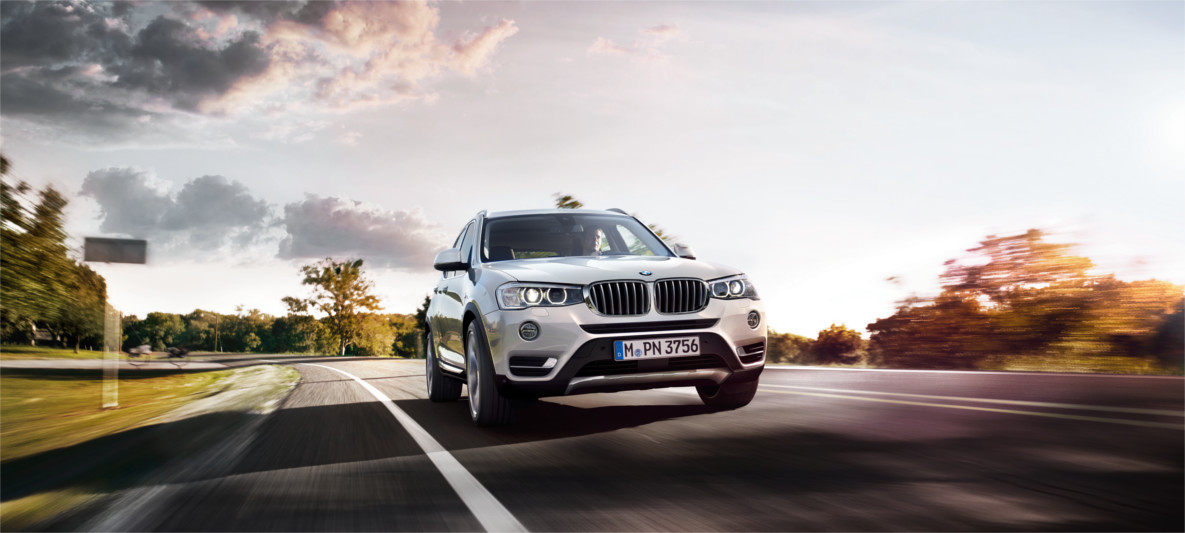
AERODYNAMICS.
The entire vehicle design is testament to the BMW EfficientDynamics philosophy. Every BMW boasts excellent air resistance figures thanks to a range of mutually optimised aerodynamic elements, which in turn has a positive effect on efficiency and fuel consumption.
For example, the flat undercarriage cover with engine compartment and rear axle shield improve the car's aerodynamics. These new casing elements are not only highly advantageous in terms of aerodynamics: they also improve sound insulation and provide greater protection from rust. Further innovations in aerodynamics include the defined rear spoiler lip and the aerodynamically optimised exterior mirrors. The latter improve the acoustics in addition to the aerodynamics and prevent the side windows from getting as dirty.

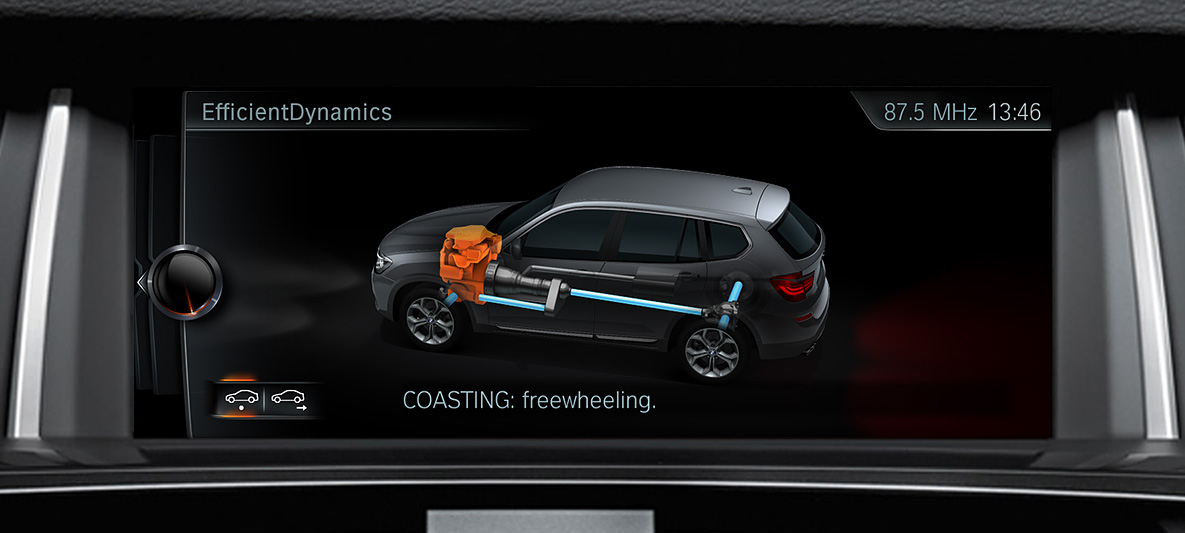

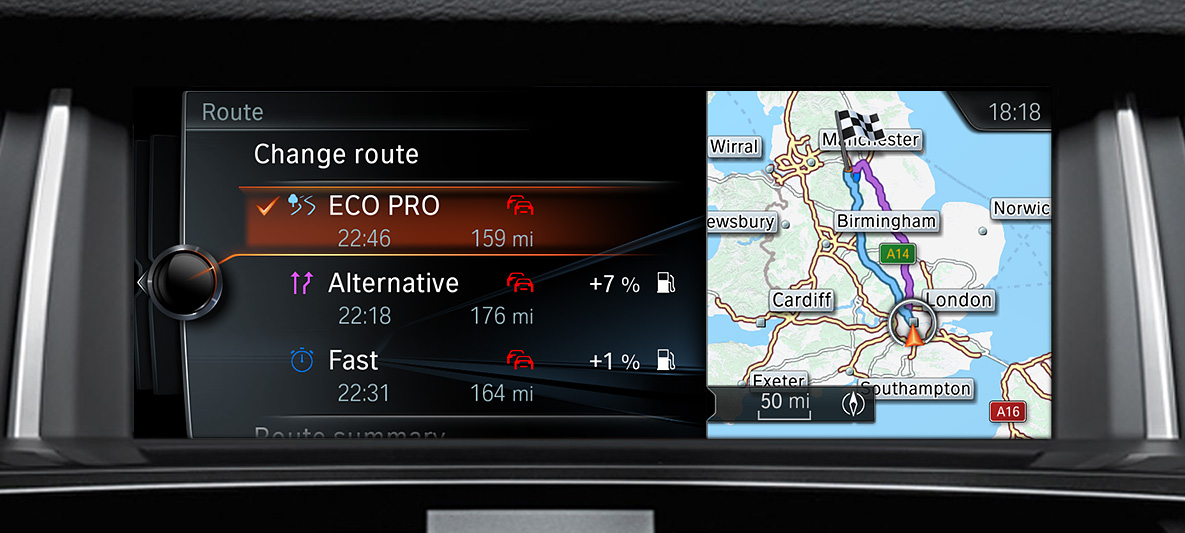
ECO PRO MODE.
The ECO PRO Mode helps drivers reduce their fuel consumption by up to 20 percent, depending on their driving style. The additional functions of coasting (only available with 8-speed Steptronic transmission), Route-Ahead Assistant (with Navigation system Professional only) and ECO PRO Route (with Navigation system Professional and Business only) can reduce consumption by a further 5 percent.
-
Coasting
The coasting function decouples the powertrain from the engine and the vehicle rolls without the transmission. The car then "coasts" when the driver takes the foot from the gas between 50 and 160 km/h, does not apply the brakes, and the Route-Ahead Assistant does not adjust the speed.
-
Active Cruise Control with Stop&Go
In combination with the Active Cruise Control, the vehicle also accelerates more efficiently after braking when in ECO PRO Mode.
-
Route-Ahead Assistant
Based on data from the navigation system, the Route-Ahead Assistant recognises curves, built-up areas, speed limits and motorway exits, and gives the driver tips in advance about when to stop accelerating.
-
ECO PRO Route
Depending on the traffic situation, the driver's behaviour and road conditions, ECO PRO Route displays the most efficient course to take. The on-board computer shows the percentage of fuel that can be saved by taking the ECO PRO Route.
8-SPEED STEPTRONIC TRANSMISSION.
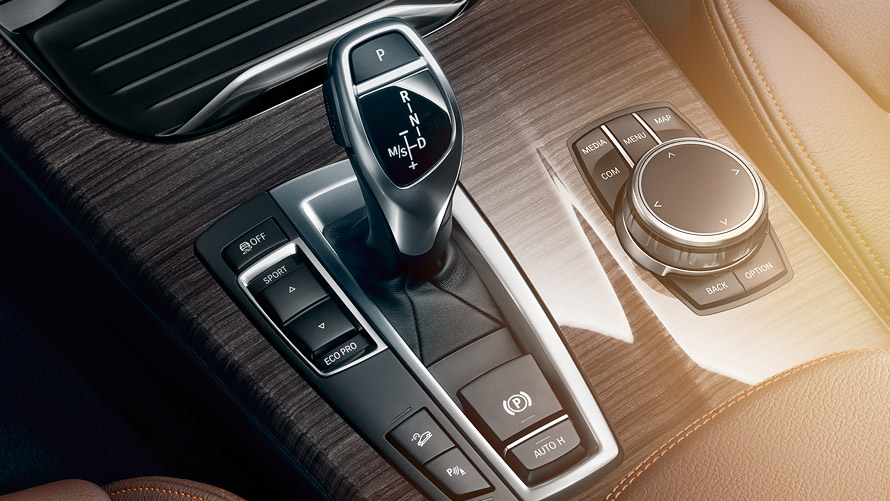
The 8-speed Steptronic transmission sets new benchmarks in comfort and dynamic performance and is a key element of BMW EfficientDynamics.
The unusually fine increments between gears facilitate optimum power delivery at all speeds. This reduces fuel consumption significantly, while allowing the driver to enjoy increased sportiness and dynamic performance. At high speeds in particular, the additional gears reduce engine speed, in turn decreasing both fuel consumption and engine noise.
The converter clutch also helps – even if the car is changed to the manual mode. In combination with the fast engine speed transitions and the precise transmission tuning, it provides a very high level of shift comfort and reduces noise considerably.
Thanks to the 8-speed Steptronic transmission from BMW EfficientDynamics, it is now possible to actively boost performance in vehicles with the new Predictive Drive Train via the Driving Experience Control. In the "Sport" mode, the transmission management uses data from the navigation system to deliver a level of responsiveness that is even more dynamic and spontaneous based on route characteristics. As suggested by its name, the "Comfort" mode offers a comfort-oriented shift programme with fewer shifts.
